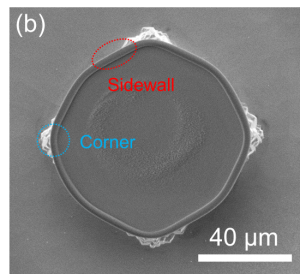Formation of photonic crystal resonators with high Q-value using nanofibers
Research
Formation of photonic crystal resonators with high Q-value using nanofibers
Toward the Ultimate Efficiency of Optical Input/Output
Photonic crystal resonators are expected to be a powerful platform for realizing optical signal processing and quantum information communication. However, the efficiency of light input/output from an optical fiber made of glass to a photonic crystal made of silicon is not high, and even when using an optimized input/output port (spot size converter), energy loss of about 10% is a problem. In addition, dynamic resonator formation at arbitrary positions is desired as a means of redesigning optical circuits and other devices through post-processing. In this study, nanofibers are placed in contact with a photonic crystal waveguide to form a highqWe have experimentally demonstrated the feasibility of critical coupling, which maximizes the input/output efficiency of light into a photonic crystal resonator by forming a photonic crystal resonator with a value of
Resonator formation on photonic crystals using nanofibers was proposed and demonstrated by Yong-Hee Lee et al. at KAIST in 2007 [1]. The principle of this method for resonance formation on photonic crystal waveguides is as follows. When a nanofiber is brought into contact with a photonic crystal waveguide, a local effective refractive index change occurs. This causes a downward shift in the cutoff frequency of the waveguide mode, resulting in a gap between the frequencies of the waveguide modes at the position where the fiber is in contact and at the position where it is not in contact (Fig. 1). Due to this gap between modes, modes with cutoff frequencies at the fiber contact position cannot propagate in the waveguide at the non-contact position and become locally confined. However, the experiments of Lee et al. used InP photonic crystals with embedded InGaAsP quantum dots, and the absorption loss of the quantum dots caused the formed resonator'sqValue is 104Theoretically, the binding efficiency was close to 100%, but the experimental efficiency was only a few %. In addition, while theoretical results showed that binding efficiencies close to 100% could be achieved, experimental binding efficiencies were only a few %.

Fig. 1: (a) Band diagram of PhC waveguides in contact with a nanofiber. (b) Schematic diagram of fiber coupled cavity and calculated Hz field profile of an The upper and lower figures are views from the top and side, respectively. Light localization is observed at the region where a silica nanofiber is placed on the top of a silicon PhC slab. © 2015 Optical Society of America.
In this study, by using silicon photonic crystal waveguidesq = 5.1 x 105The resonator formation with high Q-value of 39% and coupling efficiency of 39% were achieved (Fig. 2(a)). In addition, theq = 6.1 x 103The critical coupling condition with an extremely high coupling efficiency of 99.61 TP2T can be realized for the mode of the nanofibers (Fig. 2(b)). The resonance wavelength of the resonant mode obtained above can be tuned by changing the contact state of the nanofibers. In addition, the position of the resonator can be selected at any position on the waveguide by changing the contact position of the nanofiber.

Fig. 2: Transmittance spectrum of a reconfigurable fiber coupled PhC cavity.
(a) The resonant mode with the highest quality factor.(b) The resonant mode with the highest coupling efficiency. © 2015 Optical Society of America.
Furthermore, a larger number of resonance modes than expected from a single resonator were observed in this experiment (Fig. 3(a)). Such transmission spectra are strong evidence for the formation of an all-pass filter type coupled resonator system. Since the surface of the photonic crystal waveguide used in this experiment has multiple concavoconvexities and convexities (Fig. 3(b)), it can be expected that multiple resonators are formed under the fiber in a side-coupled state with the nanofiber. The formation of such a coupled resonator system is a new knowledge obtained in this study, and is expected to be applied as a delay device to slow down the effective propagation of light.
The results of this research are useful for the realization of quantum information communication, which requires highly efficient optical signal processing and low-loss optical input/output.

Fig. 3: (a) Transmittance spectra of TE and TE polarized light. The vertical axis is normalized with the maximum transmittance of the tapered fiber. SEM image of PhC waveguide surface.
[1] Myung-Ki Kim, et al. , "Reconfigurable microfiber-coupled photonic crystal resonator," Opt. Express. 15, 17241- 17247 (2007).- Categories
- 研究トピックス



